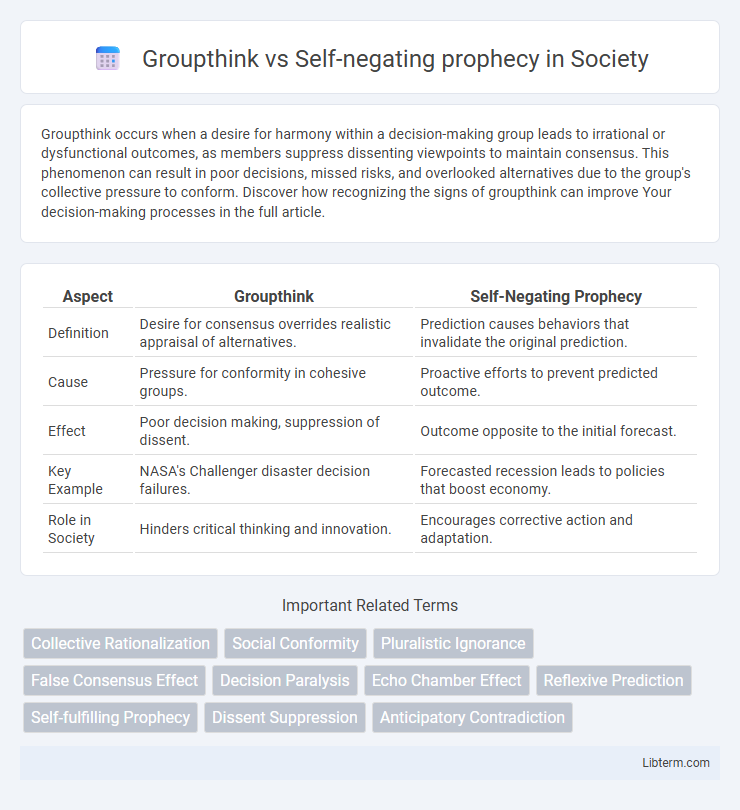Groupthink occurs when a desire for harmony within a decision-making group leads to irrational or dysfunctional outcomes, as members suppress dissenting viewpoints to maintain consensus. This phenomenon can result in poor decisions, missed risks, and overlooked alternatives due to the group's collective pressure to conform. Discover how recognizing the signs of groupthink can improve Your decision-making processes in the full article.
Table of Comparison
| Aspect | Groupthink | Self-Negating Prophecy |
|---|---|---|
| Definition | Desire for consensus overrides realistic appraisal of alternatives. | Prediction causes behaviors that invalidate the original prediction. |
| Cause | Pressure for conformity in cohesive groups. | Proactive efforts to prevent predicted outcome. |
| Effect | Poor decision making, suppression of dissent. | Outcome opposite to the initial forecast. |
| Key Example | NASA's Challenger disaster decision failures. | Forecasted recession leads to policies that boost economy. |
| Role in Society | Hinders critical thinking and innovation. | Encourages corrective action and adaptation. |
Understanding Groupthink: Definition and Key Features
Groupthink is a psychological phenomenon where the desire for harmony and conformity within a group results in irrational or dysfunctional decision-making outcomes. Key features include suppression of dissenting opinions, shared illusions of unanimity, and an unquestioned belief in the group's morality. This dynamic stifles individual creativity and critical thinking, leading to poor judgments and overlooking alternative solutions.
What is a Self-Negating Prophecy?
A self-negating prophecy occurs when a prediction or belief causes actions that prevent the predicted event from happening, effectively refuting itself. Unlike groupthink, which involves collective conformity leading to poor decisions, a self-negating prophecy highlights the paradox where awareness of the forecast alters outcomes. This phenomenon is critical in psychology and sociology, illustrating how expectations influence behaviors and realities.
Origins and Psychological Roots of Groupthink
Groupthink originates from social psychological research by Irving Janis in the 1970s, emphasizing conformity pressure within cohesive groups that suppress dissent to maintain harmony. Its psychological roots lie in individuals' desire for acceptance, fear of rejection, and the avoidance of conflict, which lead to faulty consensus and overlooked risks. This contrasts with the self-negating prophecy, where beliefs or predictions cause actions that invalidate the original expectation.
Mechanisms Behind Self-Negating Prophecy
Self-negating prophecy occurs when a prediction influences behavior that prevents the predicted event from happening, contrasting with groupthink where collective conformity suppresses dissenting opinions. The primary mechanism behind self-negating prophecy involves feedback loops where awareness of the prophecy prompts actions that nullify the original expectation. This dynamic reliance on anticipatory behavior highlights how beliefs can actively reshape outcomes, disrupting the self-fulfilling nature of typical prophecies.
Comparing Groupthink and Self-Negating Prophecy: Core Differences
Groupthink occurs when group cohesion leads to consensus without critical evaluation, often suppressing dissenting opinions and resulting in poor decision-making. In contrast, a self-negating prophecy involves a prediction that prevents itself from coming true because awareness prompts actions that alter its outcome. The core difference lies in groupthink's focus on social conformity pressures impairing judgments, while self-negating prophecy centers on the effects of anticipatory behavior changing expected events.
Real-World Examples of Groupthink in Action
Groupthink occurs when cohesive groups prioritize consensus over critical evaluation, leading to flawed decisions such as the Bay of Pigs invasion where U.S. officials ignored dissenting opinions, resulting in a failed military operation. The Challenger Space Shuttle disaster exemplifies groupthink as NASA engineers suppressed concerns about O-ring failures to avoid conflict, culminating in a catastrophic explosion. Corporate scandals like Enron also demonstrate groupthink, where executives ignored ethical warnings to maintain an illusion of profitability, causing one of the biggest financial collapses in history.
Self-Negating Prophecy in Society: Notable Case Studies
Self-negating prophecy occurs when a prediction or belief about a future event prompts actions that prevent the event from happening, disrupting originally expected outcomes. Notable case studies in society include the 2000 Y2K scare, where widespread fear of technological failures led to proactive system upgrades, ultimately avoiding anticipated chaos. Another example involves economic forecasts predicting recessions, which can trigger policy measures and consumer behavior that prevent or lessen the forecasted downturn.
Consequences: The Impact of Groupthink vs. Self-Negating Prophecy
Groupthink often leads to poor decision-making and diminished innovation as consensus overrides critical analysis, resulting in overlooked risks and flawed strategies. Self-negating prophecy causes behavioral shifts that invalidate the original prediction, disrupting expected outcomes and creating feedback loops that can either remedy or exacerbate situations. Both phenomena significantly influence group dynamics and outcomes, with groupthink fostering conformity-induced errors and self-negating prophecy altering realities through anticipatory actions.
Preventing Groupthink and Self-Negating Prophecy: Strategies and Solutions
Preventing groupthink requires fostering an open communication culture where diverse perspectives are encouraged, and critical evaluation of ideas is standard practice. To avoid self-negating prophecy, regularly revisiting assumptions and outcomes helps identify and correct beliefs that may invalidate themselves through their impact. Implementing structured decision-making techniques, such as devil's advocacy and anonymous feedback, significantly reduces the risks associated with groupthink and self-negating prophecies.
Choosing the Right Approach: Cultivating Healthy Group Dynamics
Choosing the right approach to cultivate healthy group dynamics involves balancing the risks of Groupthink and Self-negating prophecy. Groupthink suppresses dissent, leading to poor decisions, while a Self-negating prophecy causes behavior changes that invalidate initial assumptions. Encouraging open communication, critical thinking, and realistic expectations promotes effective collaboration and prevents harmful decision-making patterns.
Groupthink Infographic

 libterm.com
libterm.com